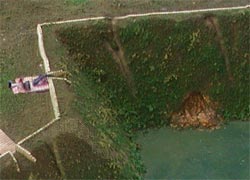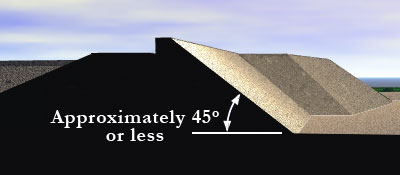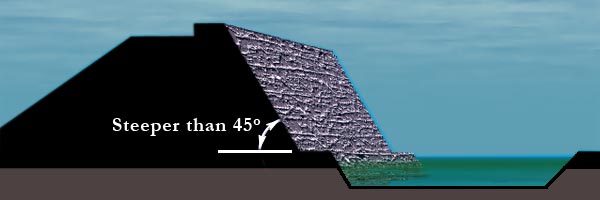 |
Face it! Was Earth the Best Material for Building a Fort? |
 |
| Earthen forts eroded to uselessness in as few as four years. |
For a readily available construction material, it was earth. It could be shoveled out to make the ditch and heaped to create the ramparts. Even if one had a construction crew of unskilled labor, all anyone had to know was how to wield a shovel, basket and wheelbarrow. Plus, construction was as fast as that earth could be dug, hauled and dumped. Such earthen forts popped up all around the Low Countries after 1568. But an earthen fort had two serious drawbacks:
- The finished fort eroded quickly. Unless continually maintained, erosion and settling of the heaped earth rendered it useless in a mere four to ten years.
- The angle of the front of the rampart of an earthen fort could not be any steeper than what mountaineers and geologists today refer to as the "angle of repose," that angle at which the material is at rest - but barely. Any steeper and it slides down.
An addition could be made to fort construction to alleviate those two problems: masonry.
To correct #1, ramparts and bastions faced and anchored with stone or brick - masonry - held up much longer to the elements. Maintenance was reduced from an ongoing challenge to fixing the occasional nuisance.
 |
For #2, earthen forts, the "angle of repose" was often in the neighborhood of 45 degrees - or less. The serious problem with that angle was that it was not sufficiently steep to prevent attackers from stepping right up the wall all the way to the top. |
|
With masonry to hold the wallwork in place, facings could be steeper than any man could leg himself up. Angles could be 60 degrees or steeper. Yet the thickness of the walls was enough that cannon could not make them topple (although the masonry could be shattered to slide down). A "revetment" was the name given to a facing of masonry. |
 |
Earthen forts continued to be built in this era, especially in the Netherlands, despite those two significant disadvantages. Why?
| Back |
Hard Walls/ Big Money |
|
|
|